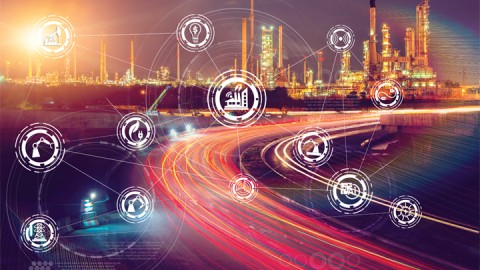As utilities transform towards more connected and distributed grids, their mobile workforces must also transform. The results of a recent survey of North American utilities yielded a range of insights on the evolving utility mobile workforce, relevant not only to US utilities, but also those within Australia and elsewhere across the globe.
Emerging technologies and innovations resulting in a more integrated, responsive, and data-rich network will provide significant opportunities for utilities’ mobile workforces to leverage real-time data and better interact with customers and the grid.
In research sponsored by Panasonic and Verizon, Zpryme surveyed over 150 respondents from North American utilities about their mobile workforces, asking questions covering changing technologies and demographics, the adoption and impacts of IoT and Smart Cities, and how prepared utilities are for these changes.
The resulting report provides a multitude of valuable insights into these subjects, and attempts to answer the million-dollar question: how can utilities best leverage new technologies and data for their mobile workforces, in order to take full advantage of the opportunities presented in a time of rapid change?
The evolving utility mobile workforce
When examining the effects of technological changes on a utility’s mobile workforce, we must also consider changes to the makeup of the workforce itself, as these are equally critical to driving innovation.
Changing demographics
Although 76 per cent of the utilities surveyed expected at least some portion of their mobile workforce to retire during the next few years, 78 per cent anticipated that their mobile workforce would grow overall.
As utility workforces age, institutional knowledge and valuable skills will be lost to retirement. However, this transition also presents utilities with a unique opportunity to introduce new mobile solutions to their workforces and attract new generations of digital natives who may be more comfortable with modern technologies than their predecessors.
Ultimately, utilities have the opportunity to adopt new approaches to their mobile workforces – and technology can play a significant role in helping make the transition between different mobile workforce generations.
Changing technologies
The overall growth and changing demographics of the mobile workforce mean new opportunities for integrating advanced data, analytics, and technology into workflows.
Digitisation is occurring across many industries, and utilities are no exception. Overwhelmingly, utilities plan to increase the digitisation of their mobile workforces (96 per cent) – with over half of the utilities surveyed saying digitisation will increase significantly in the next one to three years (54 per cent).
Instrumental to successfully digitising mobile workforces are fast, rugged, and reliable mobile devices. Mobile phones and consumer laptops make up the bulk of the mobile devices utilised today. However, other technologies – such as rugged laptops, tablets, and handhelds – are also seeing uptake.
Utilities are also planning to adopt new technologies, such as wearables (24 per cent), and augmented reality devices (19 per cent), to enable their mobile personnel with new opportunities for connectivity.
In addition to mobile devices, connectivity among devices is critical for digitisation. Over the next three years, 88 per cent of surveyed utilities plan to increase their use of cellular connectivity for mobile devices – with 35 per cent planning for significant increases.
Technology reshaping the mobile workforce
While the foundation of mobile workforce digitisation involves mobile devices and communications, emerging technologies are adding new layers of connectivity and complexity.
Innovations such as the Internet of Things (IoT) and Smart Cities will create incredibly data-rich and connected environments for the mobile workforce.
Most utilities agree on the importance of both IoT and Smart Cities. This means the next step is implementing strategies to leverage the maximum benefits of these technologies.
Two key areas where utilities expect to benefit are business efficiencies and customer service enhancements.
The most common business benefits from IoT and Smart Cities expected by respondents were improved operational efficiency (77 per cent), access to real-time information (35 per cent), and reductions in restoration times (29 per cent).
Improved operational efficiency is the most valuable improvement to overall business efficiency due to a more connected and knowledgeable mobile workforce, as well as the opportunity for more automation among distributed assets and personnel.
But are utilities prepared?
Given the potential benefits of embracing IoT and Smart Cities technologies in the mobile workforce, utilities must create the infrastructure to support these advances.
To reap the full benefits of these technologies, utilities need secure mobile infrastructure to embrace an emerging data-rich, real-time and connected environment.
Responses to the survey indicated that 33 per cent of utility respondents felt prepared, with seven per cent feeling very prepared, to take on this change. But there is still some hesitancy, with 20 per cent of respondents reporting that they felt unprepared.
Currently, most utilities are making progress in preparing access to back office systems, IT support to field workers, real-time analytics capabilities, mobile device form factors, and mobile device reliability.
To maximise the efficiency of the new data-rich mobile infrastructure, utilities also need a reliable wireless communications network. Cellular connectivity is an important factor for managing high-volume data, as well as interacting with utility customers.
In addition to needing sustainable digital infrastructure, the mobile workforce itself must also be equipped to make the shift toward digitisation.
Overall, most organisations are starting to prepare their mobile workforces for the increase in real-time data. They are also working toward enhancing the customer experience through new customer engagement opportunities.
For example, 43 per cent of utilities surveyed revealed they are at least somewhat prepared for the sales of new customer products and services, and 39 per cent feel at least somewhat prepared for remote access to customer care and billing. Only eight per cent of respondents did not feel at all prepared to share real-time data with customers.
Preparing for tomorrow’s mobile workforce, today
The shift toward a real-time, incredibly connected environment is imminent for today’s utility mobile workforce – and utilities are preparing for this immense change.
There are a number of steps that utilities can take to prepare, in order to successfully make the digital transition and reap the benefits of technological change.
- Utilities need to ensure that their mobile devices provide the security, efficiency, and reliability to handle the increasing demands placed on mobile workforces. Selecting rugged solutions with the lowest failure rates will help maintain the highest levels of productivity in the field.
- Network security and data privacy are top challenges in the utility digitisation era. Opting for enterprise-grade devices over consumer-grade devices can help utilities alleviate these concerns. These rugged mobility solutions are designed specifically to securely integrate real-time data and analytics into the increasingly connected environment of mobile workforces.
- Mobile devices should operate with reliable sustainable digital infrastructure and communications networks that integrate new technologies, like IoT and Smart Cities, with existing processes.
- Utilities should ensure that mobile devices are connected to a reliable wireless network, such as an LTE network, to strengthen all communication efforts within each utility and with customers.
- Lastly, simplicity is the key when building a digital interface because it allows maximum use across the widest range of employees. The more employees can connect with customers and each other, the more beneficial a digital infrastructure becomes.















